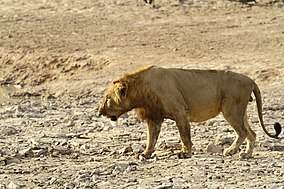Arly-Singou
| Arly-Singou | |
|---|---|
 | |
 | |
| Location | Burkina Faso |
| Nearest city | Diapaga |
| Coordinates | 11°35′N 1°28′E / 11.583°N 1.467°E |
Arly-Singou is a 6,388 km2 (2,466 sq mi) large ecosystem in Burkina Faso.[1] It encompasses the Arli National Park and the Singou Reserve.[2] It is considered to comprise part of the most significant and important savanna woodland wildlife areas still existing in West Africa.[citation needed]
Fauna and history
In 1980, aerial counts revealed that the largest antelope population in the entire region inhabited the Arly-Singou complex. More recent studies indicate that the antelope population has been sustained by the end of the 20th century.[3]
In 2003, herds of African elephant, buffalo, roan antelope, western hartebeest, oribi, Grimm's duiker, Buffon's kob, bushbuck, waterbuck, bohor reedbuck and groups of warthog, anubis baboon and Patas monkey were recorded in Arly-Singou during an aerial survey.[2] In 2002, it was estimated that between 364 and 444 lions reside in Arly-Singou, based on information by local people. But census data were not available.[4] In 2004, census data were still not available. Based on information by wildlife researchers, it was estimated that 50 to 150 lions reside in Arly-Singou.[1]
Previously the endangered painted hunting dog, Lycaon pictus, occurred in Burkina Faso within the Arly-Singou ecosystem, but, although last sightings were made in Arli National Park, the species is considered extirpated throughout Burkina Faso.[5]
The Arly-Singou project is considered to have taken a somewhat new initiative in structure, in regard to wildlife management undertakings funded by the government in the area. However, the project also permits private operators to share and hold authority of the area's management, in a bid to take advantage of the benefits of greater external funds, from these operators.[citation needed]
See also
References
- ^ a b Bauer, H.; Van Der Merwe, S. (2004). "Inventory of free-ranging lions Panthera leo in Africa". Oryx. 38 (1): 26–31. doi:10.1017/S0030605304000055.
- ^ a b Bouché, P., Lungren, C. G., Hien, B. and Omondi, P. (2004). Aerial Total Count of the "W"-Arli-Pendjari-Oti-Mandouri-Keran (WAPOK) Ecosystem in West Africa. April-May 2003. Benin, Burkina Faso, Niger, Togo: PAUCOF.
{{cite book}}: CS1 maint: multiple names: authors list (link) - ^ East, R. (1999). African antelope database 1998. Volume 21. IUCN. ISBN 2-8317-0477-4.
- ^ Chardonnet, P. (2002). "Chapter II: Population Survey". Conservation of the African Lion : Contribution to a Status Survey. Paris: International Foundation for the Conservation of Wildlife, France & Conservation Force, USA. pp. 21–101.
- ^ Michael, C. Hogan (2009-01-31). Stromberg, N. (ed.). "Painted Hunting Dog: Lycaon pictus". GlobalTwitcher.com. Archived from the original on 2010-12-09.
{{cite journal}}: Cite journal requires|journal=(help)
Further reading
- Henschel, P.; Bauer, H.; Sogbohoussou, E.; Nowell, K. (2015). "Panthera leo (West Africa subpopulation)". IUCN Red List of Threatened Species. 2015.
- Ouédraogo, O.; Schmidt, M.; Thiombiano, A.; Hahn, K.; Guinko, S.; Zizka, G. (2011). "Magnoliophyta, Arly National Park, Tapoa, Burkina Faso". Check List. 7 (1): 85–100. doi:10.15560/7.1.85.
- "CONSIDERATION OF PROPOSALS FOR AMENDMENT OF APPENDICES I AND II" (PDF). Archived from the original (PDF) on 3 February 2007. Retrieved 11 September 2007.
